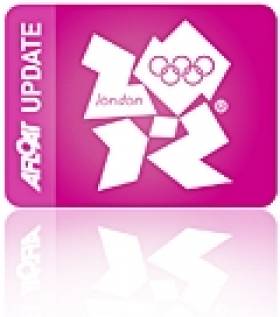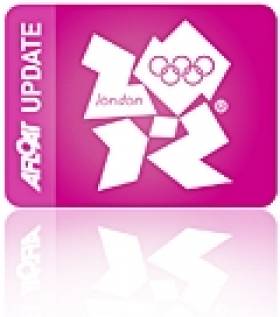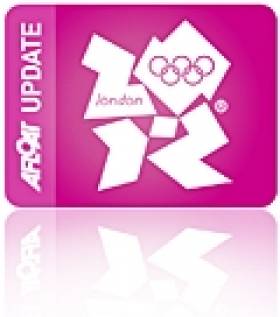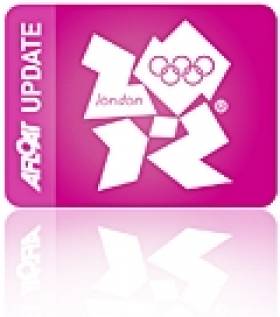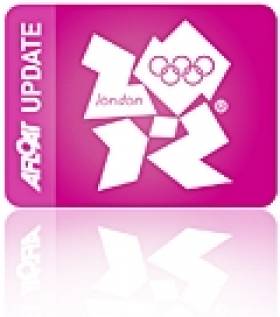Displaying items by tag: Laser Radial
Finn Fights to Stay Olympic Dinghy Class
The Council are going to be asked to confirm six core events and these it is understood will most likely will be Men and Women Boards, Laser and Laser Radial and Men and Women Skiff.
Once these are selected the other four events will be considered and the Olympic Commission has suggested that 4 of the following 6 be picked:
Men's Heavyweight (Finn)
Women's other weight division in singlehanded
470 mixed
Multihull mixed
Men's Keelboat
Womens Keelboat
With the commission recommending equal gender balance, the Finn is unlikely to stay on its own and would need another women's singlehander to be selected.
The multihull is almost certain to get in, and there probably will be strong support for men and women's keelboat leaving it to be fought out between the Finn, the 470(mixed) and a Women's single handed dinghy.
Many believe the second decision will be deferred until May, but as one ISAF insider told Afloat.ie "I would be selling my Finn now if I had one".
Meanwhile the Finn class association don't see it that way at all. Under the threat of possible deselection the heavyweight men have been mobilising for a fight. Below are details of its recent campaign to stay an Olympic boat. Scroll down for nice Video too.
International Finn Association Press Release
The Finn - an outstanding display of sailing skills and athleticism
The Olympic Commission set up by ISAF delivered its preliminary report at the ISAF Conference in May 2010. Based largely on the Olympic Commission report, the ISAF Executive has since published two submissions which outline an exciting new future for the selection and decision making process for Olympic sailing events and equipment. The Finn is positioning itself to be part of that future.
Among the submissions are proposals for two sets of single-handed dinghies for both male and female sailors, to represent the weight and size distribution of modern youth of both genders in the most popular and low-cost type of dinghy sailing. The Finn class supports this idea.
Here are some of the arguments why Finn sailors think the Finn should remain part of the Olympic sailing equipment.
Tough challenge
The Finn is widely regarded as one of the toughest physical challenges in sailing. Sailors have to be tough, strong, fit, agile and athletic, while managing the mental aspects of racing at the highest level. The current world champion has a VOR max comparable with marathon runners and cross country skiers. Winning takes dedication, commitment and performing at the limits of fitness and endurance.
Appealing racing visuals
Modern looking rigs and hulls. Beautiful boat to sail with athletic, fit, muscular sailors. Requires extreme physical effort to sail well. Golden sail insignia for former world champions from 2011. Continuing research into sailor identification and country flags on sails. The free pumping rule has transformed downwind sailing into an absorbing display of skill, strength and athleticism.
Standard boats
Finns can be bought 'off-the-shelf' and be winning the next day. Hulls, masts and sails have all evolved into a level plateau of standardisation that means boats can compete on a level playing field. The strict class rules limits any experimentation into 'super' boats. Boats that are sold year after year are identical within reasonable limits and do not change perceivably over time.
Low costs
The Finn has one of the lowest running costs of any Olympic equipment. Average campaign costs from 35 sailors was just EUR 7,500 a year. One boat can last at least two Olympic cycles. Gear standardisation has meant reduced development costs. Gear is fast and ready to sail 'out of the box'. Increasing IHC and building control is reducing regatta measurement requirements, while 99% of checks at regattas pass first time.
Consistent equipment
Today's Finns are the most consistent, accurate and reliable Finns ever built. A modern Finn can be expected to be competitive for 6-8 years. The Finn is one of the most consistent hulls made today, thanks to very professional builders and strict measurement rules. Modern materials and new technologies means that boats supplied all over the world are as alike as possible in almost every way.
Easier rules
A proposal was passed at the 2010 AGM to lower the free pumping limit to 10 knots. This was aimed to make Rule 42 enforcement easier for judges and sailors. Under 10 knots there are much less opportunities for pumping and surfing. Identifying illegal activity is much easier, so less emphasis on judging decisions. Sailors are educated in Rule 42 – frequent clinics with the active involvement of judges and website coverage.
Worldwide culture
Local builders are producing low cost Finns for regional competition. Having been on the Olympic Programme since 1952, the Finn has the deepest culture and traditions of any dinghy class. Semi-professional class organisation oversees all activities. All levels of competition from Juniors (U21) to Masters (40+) and everything in between. Many countries are developing Junior programmes to fast track talented sailors.
Global spread
Finns are now built in the UK, Poland, Hungary, Czech Republic, Brazil, USA and South Africa, and there are other countries to come. Elsewhere, suppliers and dealers feed local fleets with new and used equipment. There are National Finn associations in more than 50 countries, while between 35 and 40 countries have internationally active sailors. Sailors from six continents attend major regattas. It is truly a global fleet.
Pinnacle event
The Finn is the pinnacle of singlehanded dinghy sailing for men, and the Olympics is the pinnacle event for the Finn. It provides a single step pathway from Optimist to Laser to Finn as the sailor's weight increases, but also allows the development of similar technical and physical skills in the sailor through a natural progression of similar equipment.
What the sailors say:
Jonas Høgh Christensen (DEN), 2006, 2009 World Champion, "The Finn is the most fun, challenging boat for strong, athletic sailors."
Giorgio Poggi (ITA), 2008 Finn Olympian, "The Finn is the class where the sailor must be complete."
Zach Railey (USA), Silver medalist, 2008 Olympics: "For single handed sailing the Finn is my only option given my weight and height to pursue my Olympic sailing dreams. With the technical and physical demands of the boat, the Finn is a pure test of a sailor's ability to react to the changing conditions on the race course under intense physical exertion."
Rob McMillan (AUS), "There is no other boat like it. The advent of free pumping brings a level of athleticism that is unique to the Finn."
Daniel Birgmark (SWE), 4th 2008 Olympics, "Sailing the Finn puts very high demands on the sailors athletic capacity as well as tactical and strategic skills. It's the perfect singlehander for sailors over 85kg."
Tomas Vika (CZE), one of many Finn sailors in their early 20s, "If you are more than 180cm tall and you want to work on your physical condition in a gym you will always weigh more than 85kg and that is the reason why Finn has to stay as an Olympic dinghy in future years."
Gus Miller (USA), Finn legend: "It's a very powerful demanding boat and you need a lot of initiative and attitude that you're going to do it yourself. Everyone realises the challenges is yourself not the other guys. The challenge is the boat and that understanding is the old idea "I love my competitor because he makes me better". The guys here have enormous respect because the challenge of sailing the boat is so great. If one guy figures it out then the others guys are glad for him that he's been able to do it."
Caleb Paine (USA), first Junior, 2010 Finn Gold Cup: "The Finn is the best class I have sailed in. There isn't I class I know of that has such a great sense of camaraderie. After my first international regatta I knew all the best Finn sailors in the world on a first name basis because they were open, friendly and supportive of the new kid. I think that this coherence of the class stems from the fact that the sailors often train together. This builds friendships as well as making everyone better."
Tapio Nirkko (FIN), 2008 Finn Olympian: "The Finn is already well developed in many areas. We're now in a situation when all the Finn equipment (hull, mast, boom, rudders, centreboards) are good quality and last a long time. When the market is competitive, the price of the equipment is also fair and resale value is good. That's an important factor to make a competitive Olympic project from a small country with a small budget. Now the actions made in the class to make equipment issues more transparent is important to keep Finn as a class where it's possible to make it to the top without having a monster budget."
Ed Wright (GBR), 2010 World Champion, on what makes the Finn class special for him: "For a start it's visually pleasant. The cost is low. I still use my first mast and it's still fast after five years. .... You can gain little advantages everywhere, but you have to treat the Finn with finesse, respect and grunt to keep it up to speed. The people in the class are great people and all hard competitors. Also there is so much history in the class, and never forget the many legends coming from the Finn."
Read more from these interviews and more about the Finn in the latest issue of FINNFARE out now
Belfast Olympic Hope Presents £18,000 Boat to Charity
Twenty-year old sailor Tiffany Brien from Royal North of Ireland Yacht Club presented an £18,000 Paralympic sailing boat to local disabled charity Belfast Lough Sailability in Belfast Harbour today – the culmination of two years of fundraising by the 2012 Olympic hopeful.
The boat was officially launched today at Abercorn Basin, Titanic Quarter Belfast and was formally named 'Will Power' by Tiffany and Len O'Hagan, Chairman of Belfast Harbour. The significance of the name relates to a very close friend of Tiffany's, Will Doggart, who was paralysed last year following an accident. Will attended the launch today and has sailed in the new boat alongside Tiffany.
The 'Skud 18' sailing boat took two years to build in Australia and is the most high tech paralympic boat available. 'Will Power' is the first of its kind to arrive in Ireland and has already been committed to the goal of qualifying for the Irish Paralympic sailing team for the 2012 Paralympic Games - with local athlete Steve Frecknell hoping to compete for a medal. The boat will be the responsibility of Carrick based sailing charity Belfast Lough Sailability who will also use the boat to help disabled sailors to sail competitively in Northern Ireland.
Tiffany Brien began her fundraising campaign two years ago when she sailed 30 miles single-handedly across the Irish Sea from Portpatrick in Scotland to Belfast Lough raising a total of £18,400. Before launching the boat today she commented: "I am so excited to be sailing the new boat in Belfast Harbour today. It feels like I have been waiting for a long time for it to arrive. It is even more exciting that the Irish Paralympic sailing team has committed to using the new boat in their campaign for the 2012 Paralympic Games - fingers crossed it helps to bring a medal back."
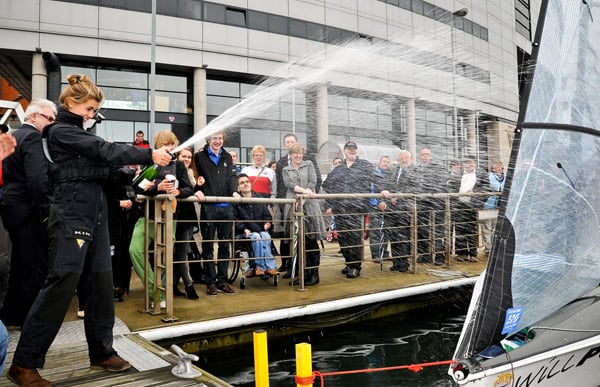
Tiffany will also be hoping to bring an Olympic medal back to Northern Ireland as she is currently competing to represent Ireland in the Laser Radial Class at the 2012 Olympic Games.
Nigel Thompson, Chairman of Belfast Lough Sailability comments: "Everyone at Sailability is totally overcome with the sheer determination and generosity Tiffany has shown in her fundraising campaign. The arrival of the boat today is the culmination of the dedication and resolve demonstrated by this young lady when she sailed singled handedly across the Irish Sea. Not only will our Paralympic hopefuls benefit from this but many other disabled sailors in Northern Ireland will get to enjoy this exceptional boat - including Tiffany's friend Will, who hopes to become an active member of Sailability and a keen sailor. We would like to thank Tiffany sincerely and wish her the best of luck in her own Olympic campaign."
Belfast Lough Sailability is a "not for profit", volunteer-based charity which, through the activity of sailing, enriches the lives of people with any type of disability, the elderly, the financially and socially disadvantaged.
Belfast Harbour has been the principal sponsor of Tiffany's Sailability campaign. BTWCairns, Airtricity, Stena Line, Belfast Telegraph and Ulster Bank and Brook House Art & Design are associate sponsors.
Wallace, Murphy and Flynn Take Laser Titles on Belfast Lough
In the Standard Rig, Ronan Wallace (Wexford B & TC) took the title from Robert Espey (Ballyholme YC) and Stpehen Mc Lernon (Cushedall SC).
Annalise Murphy (National YC) won the Radial Championships from Philip Doran (Courtown SC) and Tiffany Brien (Ballyholme YC).
Annalise won 4 of the 8 races sailed including all three in the 16-20 knot breeze on Saturday. The National YC sailor becomes the first female sailor to take the Laser Radial Irish National title.
The 4.7 rig was won by John Flynn (Dungarvan SC) from Colm O Regan (Kinsale YC) and Stephen Duke (Courtown SC). The first girl in the 4.7 was Georgina Corbett (LDYC/NYC).
Ireland Racing for Medals in Star and Laser Radial
Ireland races in two medal races tomorrow at the Skandia Sail for Gold Regatta following strong performances by its Olympic squad across dinghy and keelboat classes. Annalise Murphy is ninth and on her way to a convincing overall performance but by far and away the stand out story in Weymouth this week has come from Royal Cork's Peter O'Leary whose speed in the Star class has beaten the very best in the world bar none. He lies at the top of the leaderboard tonight seven points clear, an achievement made all the more remarkable because he sailed with a standby crew, German sailor Fritjof Kleen, without any pre event practice.
Today we saw the gold fleets split off. The majority of the sailors were dispatched to silver and bronze fleets – with no more chance at the podium. But if that was a deep cut, then the next will hurt even more, as many top seeds have just one more day to rescue themselves. Tomorrow night the top ten will be decided for Saturday's medal races, and if you have to be in it to win it.
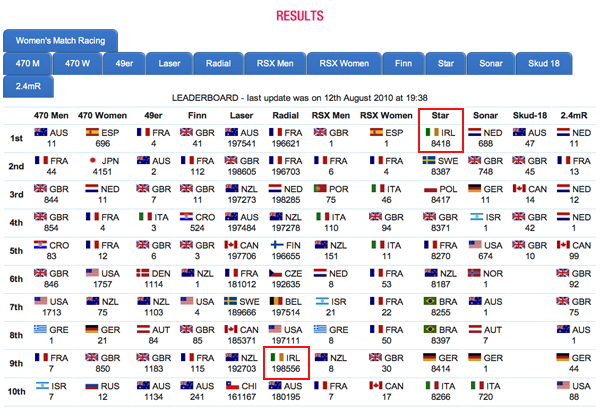
The leaderboard tonight at the Skandia Sail for Gold Regatta showing Ireland in the hunt for two medals
The 470 Women have been brutally competitive all week, as we highlighted yesterday. No less so today, where the Dutch World Champions and overnight leaders Lisa Westerhof and Lobke Berkhout dropped to third - the Spanish team of Tara Pacheco and Berta Betanzos are now taking the top spot. The situation is even worse for the Danish team that was third overall in the ISAF Sailing World Cup going into this regatta - Henriette Koch and Lene Sommer are currently lying 12th - over the edge for the medal race if they can't pick up a couple of places tomorrow.
There's another big name in trouble in the 470 Women and that's double Yngling gold medallist Sarah Ayton and her crew Saskia Clark, now in 18th and 31 points adrift of the medal race. But e can't leave the 470s without some good news, and a mention for an outstanding performance today from Americans Erin Maxwell and Isabelle Kinsolving, who scored two bullets. The 470 Men were a little more predictable, with World Champions Matt Belcher and Malcom Page ascending to the top of the leaderboard, and none of the top seeds looking like missing the cut.
In the Stars, there were some very familiar names around the medal race cut - Szabo and Strube in 10th, Mendelblatt and von Schwarz in 11th (they were looking for a podium in the ISAF SWC going into this regatta), Marazzi and de Maria in 12th (second placed at the 2010 Worlds), Negri and Voltolini in 13th, Rohart and Ponsot in 14th, Campbell and Funk in 16th, Horton and Lynne (also looking for a podium in the ISAF SWC) - and on it goes, but I guess that's the Star fleet for you... O'Leary and Frithjof Kleen still control the fleet with a seven point lead. O'Leary's rivals Max Treacy and Anthony Shanks who were 25th overall did not compete in either race today.
I guess the most worried man in the Finn fleet right now would be Rafael Trujillo. The Spanish silver medalist (Athens, 2004) was on form at the Europeans with a fourth, but is currently lying in 14th and staring the cut for the medal race in the face. The outstanding performer in that fleet today was the Brit... no, not Ben Ainslie, but Giles Scott. Scott scored a second and a third to go to the top of the scoreboard, pushing aside the long-time leader, Frenchman Jonathan Lobert.
In the 49er the Brits, John Pink and Rick Peacock, were second at the Worlds in 2009, but are struggling just below the cut in 11th - a good day tomorrow should get them through. Also in trouble are the top guys in the ISAF Sailing Cup, so we could see that settled early. Leading the SWC into this regatta was Nico Luca Marc Delle Karth and Nikolaus Leopold Resch, who look safe in eighth place tonight. But chasing them was Allan Norregaard and Peter Lang who may not make it into the medal race, currently 12th. That would play into the hands of SWC third placed Manu Dyen and Stephane Christidis – the Frenchmen are still leading Skandia Sail for Gold.
In the RS:X MEN, the Beijing gold medallist and 2008 World Champion, New Zealander, Tom Ashley is close to the drop, in ninth place after an eighth and an eleventh today. Otherwise it was service as usual, with the top seeds in good shape. Britain's Athens Bronze medallist, Nick Dempsey still leads overall by four points. Things are all also going according to plan in the RS:X Women, where none of the seeds are in danger. The Spanish sailor and last year's Skandia Sail for Gold Champion, Blanca Manchon, retains her lead.
In the Laser Radials it's Tatiana Drozdovskaya from Belarus who's in trouble - fifth at the worlds and currently lying 15th. The top American sailor, Page Railey is also in a bit of trouble in eighth, but she helped her cause no end with a second this afternoon. Another Radial sailor that got themselves out of danger was today's outstanding performer, Sari Multala – the 2010 World Champion and last years Skandia Sail for Gold winner sailed beautifully to get a fourth and a first and move up to fifth.
The Laser Men were last on the water, and full results were not published when we went to press (as they used to say in the good old days). But names to watch that are near the drop zone for the medal race cut are the UK's Nick Thompson, second in the ISAF Sailing World Cup going into this regatta. And from Chile, Matias Del Solar, France's Jean Baptiste Bernaz, Spain's Javier Hernandez and Austria's Andreas Gertizer were all struggling. Australia's Tom Slingsby, winner here last year, was leading overall – by a long way.
There are four fleets that are unconcerned by the threat of the cut for the medal race, and one of them is the Women's Match Racing, now at the quarter final stage. It got exciting very quickly when the round robin produced a QF between the ISAF Sailing World Cup's overall leader, Great Britain's Lucy and Katie MacGregor and Annie Lush, and the US team just one point behind them – Anna Tunicliffe, Molly Vandemer and Debbie Capozzi. Victory for either would put the other out of the running for the ISAF SWC title. And it was the Americans that held the advantage at the end of play – 2 – 0 up, and with Macgregor receiving a -0.75 penalty for damage done in a collision.
We talked to Lucy Macgregor afterwards, "I'm pretty gutted really [that the two Quarter Final matches out there didn't go to plan]... The next match is really crucial; it's the first to three points so we will be having a good night's rest, coming back fighting in the morning and putting everything into it. They didn't let us get away with anything out there - positionally they were good, but we felt pretty strong against them around the course, so really gutted to come away with a 2- 0 defeat."
And Anna Tunnicliffe had this to say afterwards, "Lucy's a great competitor and we still have plenty of racing ahead of us. We put ourselves in a good position [for a Semifinal spot] and tomorrow's a new day, so hopefully we will continue. It was very tricky sailing out there, very shifty, very puffy, the boat behind downwind had very powerful control of the race and Lucy always ran behind us and made it really hard on us."
Three other classes finish their regatta tomorrow without the complication of a medal race. So we really are at the business end of the regatta for the Skud-18s, where the Australian pair of Daniel Fitzgibbon and Rachael Cox have been battling with GBR's Alexandra Rickham and Niki Birrel. The pair had traded first and second places until the final race of today, when Rickham and Birrel had a rudder problem and were forced to retire. It's given the Aussies a four point advantage going into the final day.
In the Sonar class, the Dutch high-fliers, Udo Hessels and Mischa Rossen once again had their wings clipped by the British team of John Robertson, Hannah Stodel and Stevie Thomas. The Brits had a great day with two thirds and a win, and are now just one point off the lead. Hannah Stodel said afterwards, "Today has not been too bad we had a second and a first, which has made the points very interesting, as we were four behind the Dutch but it looks like they had an average day. I am not sure if we are first, but it will be tight, the conditions were shifty and pretty exciting today, luckily it's our favourite condition... random!"
In the 2.4mR, France's Damien Seguin and the Netherlands Thierry Schmitter continued their week long battle. Schmitter had got the advantage going into the final race, but then slipped to fifth, allowing Seguin to take back the overnight lead – this one looks like it will be settled in the final beat of the final race.
(results conditional on protests)
470 Woman Results (After eight races)
1st Pacheco and Betanzos ESP 43 points
2nd Kondo and Tabata JPN 45 points
3rd Westerhof and Berkhout NED 49 points
4th Petitjean and Douroux FRA 53 points
5th Rol and Defrance FRA 57 points
470 Men Results (After eight races)
1st Belcher and Page AUS 20 points
2nd Leboucher and Garos FRA 21 points
3rd Patience and Bithell GBR 31 points
4th Asher and Willis GBR 33 points
5th Fantela and Marenic CRO 38 points
49er Results (After ten races)
1st Dyen and Christidis FRA 28 points
2nd Outteridge and Jensen AUS 30 points
3rd Morrison and Rhodes GBR 36 points
4th Sibello and Sibello ITA 47 points
5th Draper and Greenhalgh GBR 52 points
Finn Results (After eight races)
1st Scott GBR 31 points
2nd Lobert FRA 32 points
3rd Wright GBR 40.3 points
4th Kljakovic Gaspic CRO 44 points
5th Ainslie GBR 45.4 points
Laser Results – (After eight races)
1st Slingsby AUS 11 points
2nd Leigh CAN 42 points
3rd Goodison GBR 50 points
4th Murdoch NZL 55 points
5th Tom Burton AUS 59 points
Laser Radial Results (After seven races)
1st Steyaert FRA 24 points
2nd De Turckheim FRA 26 points
3rd Bouwmeester NED 27 points
4th Winther NZL 29 points
5th Multala FIN 34 points
RS:X Men Results (After eight races )
1st Dempsey GBR 18 points
2nd Bontemps FRA 22 points
3rd Van Rijsselberge NED 26 points
4th Tobin NZL 27 points
5th Rodrigues POR 27 points
RS:X Women Results (After eight races)
1st Manchon ESP 26 points
2nd Picon FRA 35 points
3rd Tartaglini ITA 40 points
4th Shaw GBR 41 points
4th Linares ITA 46 points
Star results – (After eight races)
1st O'Leary and Kleen IRL 28 points
2nd Loof and Tillander SWE 38 points
3rd Kusznierewicz & Zycki POL 42 points
4th Percy and Simpson GBR 45 points
5th Florent and Rambeau FRA 46 points
Women's Match Racing
Quarter Final 1
Souter, Curtis and Price AUS and Kjelleberg, Kallstrom and Harryson SWE tied 1-1
Quarter- final 2:
Leroy, Riou and Bertrand FRA and Spithill, Eastwell and Farrell AUS tied 1-1
Quarter -final 3:
Renee Groeneveld, Annemieke Bes, Brechtje van der Werf and Sally Barkow, Alana O'Reilly, Genny Tulloch tied 1-1
Quarter -final 4:
Tunicliffe, Vandemer and Capozzi USA leads Macgregor, Lush and Macgregor GBR 2- -0.75 (0.75 points deducted from Macgregor for damage)
2.4mR Results – (After eight races)
1st Damien FRA 11 points
2nd Schmitter NED 11 points
3rd Kol NED 22 points
4th Tingley CAN 32 points
5th Pascoe GBR 42 points
Skud-18 Results – (After eight races)
1st Fitzgibbon and Cox AUS 8 points
2nd Rickham and Birrell GBR 12 points
3rd McRoberts and Hopkin CAN 20 points
4th Hovden and Millward GBR 27 points
5th Hall and Faulks GBR 33 points
Sonar Results – (After eight races)
1st Hessels and Rossen NED 14 points
2nd Robertson and Stodel GBR 15 points
3rd Kroker and Prem GER 21 points
4th Cohen and Vexler ISR 26 points
5th Doerr and Freund USA 31 points
Big Breeze Brings Big Results in Weymouth
Peter O'Leary and newly adopted German crew Frithjof Kleen were winners in the single Star keelboat race today but only after an international jury granted redress to the Cork helmsman who crossed the line second at the Skandia Sail for Gold regatta in Weymouth this afternoon. A second win for Ireland was secured in the big breeze by Annalise Murphy in the Laser Radial class who also scored second in this morning's race, rounding off a successful day for the 11 strong Irish crew off the Portland Bill. Below is a podcast update from Team Manager James O'Callaghan as the crews came off the water this evening.
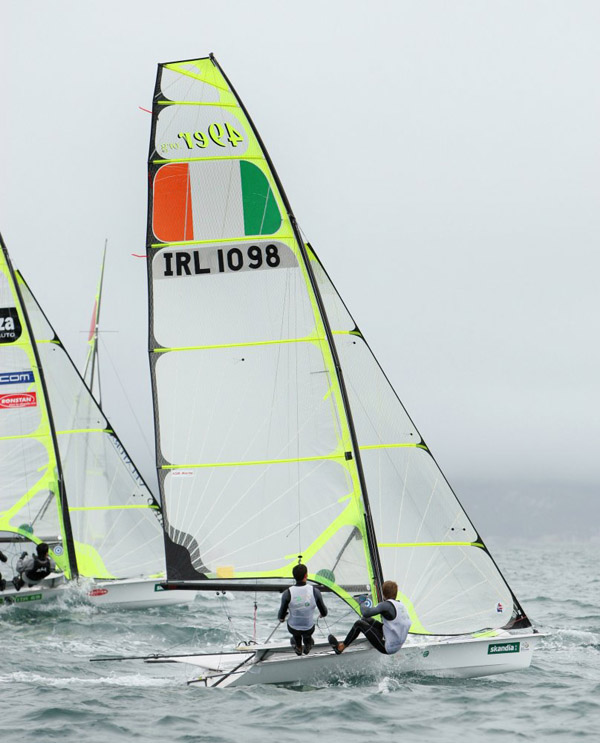
(Above) Ed Butler and Ben Lynch (IRL) in action in the 49er class on day 2 of the Skandia Sail for Gold Regatta and (below) Saskia Tidey in the Laser Radial . Photo OnEdition
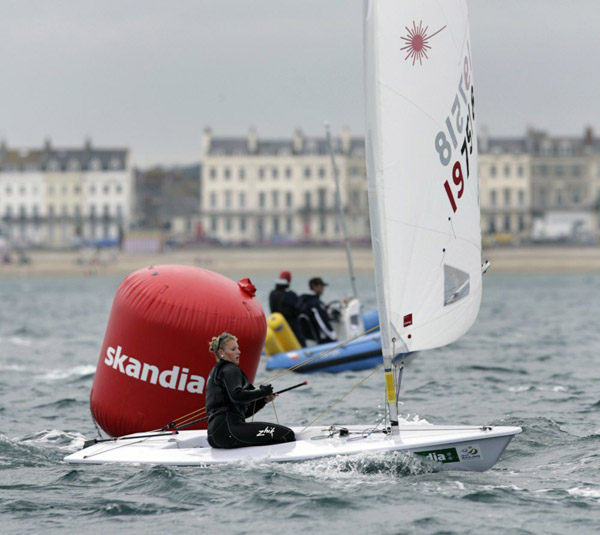
Murphy Wins Radial 'Connaughts' on Dublin Bay
A strong entry of 112 including Chile's Matias Del Solar, currently ranked seventh in the world, competed for the Connaught Laser championships this weekend on Dublin Bay. Hosted by the National YC under international race officer Con Murphy, the three Saturday races were sailed in a 10-15kt shifty westerly. Sunday saw alight breeze swing from NW to SW and then back around to North andeventually an Easterly, resulting in several postponments andultimately 2 of the planned 3 races being sailed. The Radial fleet hadthe largest fleet of 48 boats and was won Annalise Murphy from thehost club with Christopher Eames from Strangford in second. Thestandard fleet was duly won by Matias Del Solar from James Espey ofBallyholme and the 4.7s were won by Howth's Diana Kissane from fellowclub sailor Cillian Mc Creer. A number of the competitors includingDel Solar, Espey and Murphy are now enroute to Weymouth for next weeks Olympic Sail for Gold regatta where similar conditions to Dublin Baycan be expected.Full results attached:-
A strong entry of 112 including Chile's Matias Del Solar, currently ranked 7th in the world, competed for the Connaught Laser championships over the August holiday weekend on Dublin Bay.
Hosted by the National YC under international race officer Con Murphy, the 3 saturday races were sailed in a 10-15kt shifty westerly. Sunday saw a light breeze swing from NW to SW and then back around to North and eventually an Easterly, resulting in several postponments and ultimately 2 of the planned 3 races being sailed.
The Radial fleet had the largest fleet of 48 boats and was won Annalise Murphy from the host club with Christopher Eames from Strangford in second. The standard fleet was duly won by Matias Del Solar from James Espey of Ballyholme and the 4.7s were won by Howth's Diana Kissane from fellow club sailor Cillian Mc Creer.
A number of the competitors including Del Solar, Espey and Murphy are now enroute to Weymouth for next weeks Olympic Sail for Gold regatta where similar conditions to Dublin Bay can be expected.
More Irish Youth Lasers in Worlds Action
Ireland's youth laser sailors are once again in action in Europe, with the Radial Youth Worlds taking place in Largs, Scotland, and the Standard Rig Youth Worls ongoing in Poland.
Chris Penney posted good results to sit 34th out of 124 after two races.
Thirteen Irish sailors will compete at Largs in the boys fleet, with just two Irish girls, Saskia Tidey and Ruth Harrington, competing.
The Radials are currently sat on shore at Largs waiting for wind, and the committee aren't in the most positive mood.
"Unfortunately, the forecast is not looking ideal, with less than 5kts of wind predicted," they say on the official website
"High pressure will dominate to leave even more uncertain conditions for the rest of the week.
"Anything from the east is not ideal because this generally creates big, gusty winds, which whistle over the hills in the surrounding the area. Also because the water is so deep here on the Clyde – 120-140 metres in some places – setting the course in relation to the wind is also a challenge."
Right, so.
No Racing Puts the Pressure on Final Day at Largs
More than five hours of frustrating drifting on the Clyde off Largs today proved to be in vain for the sailors awaiting racing at the Laser Radial World Championships.
The mirror like waters were only occasionally ruffled by light airs from conflicting directions, and only – as the race officers' version of Murphy's Law would have it – as the appropriate signals were made, was there anything close to a breeze.
Sari Multala, Finland's defending world champion goes into the final day of scheduled racing with a lead of seven points over Marit Bouwmeester (NED).
It will be an interesting finale. Forecasts conflict as to how much or how little breeze there will be and the opinions seem to be towards either extreme.
Even if there are three races for the Women's gold fleet there can only be one discarded result and Bouwmeester has not finished outside the top ten so far, whilst Multala has a weighty 49th from Race 4 as her throwout.
In the Men's fleet it is champion Marcin Rudawski (POL), also the defending 2009 who enters the last day at Largs with a six points lead and only a seventh place as his discard, whilst fellow Pole Wojciech Zemke lies second and the USA's impressive 16 year old Mitchell Kiss lies third.
Standings: Laser Radial Womens World Championships
Gold Flight Overall After race 6 Inc. 1 discard
1 S Multala (FIN) 4,3,1,(49),2,5, Nett = 15pts,
2 M Bouwmeester (NED) 2,1,5,(7),6,8,= 22pts,
3 P Railey (USA) 3,1,4,16,(17),3 = 27pts,
4 S Steyaert (FRA) 23,4,1,3, 15,4, = 27pts,
5 T Drozdovskaya (BLR) 1,5,14,3,(32),13, = 36pts,
6 T Mihelic (CRO) 15,8,3,8,(35),6, = 40pts,
7 A Tunnicliffe (USA) 1,2,37,(49),5,2, = 47pts,
8 E Van Acker (BEL) 6,11,(21),14,1,15, = 47pts,
9 G Scheidt (LTU) 13,19,2,4,(40),11, = 49pts,
10 M de Kerangat (FRA) 18,7,15,5,(19),10 = 55pts,
Laser Radial Mens World Championship 2010
Overall After Race 6 Inc. 1 Discard
1 M Rudawski (POL) 1,2,1,1,1,(7), Nett = 6pts,
2 W Zemke (POL) 1,1,2,1,7,(OCS[48]), = 12pts,
3 M Kiss (USA) 4,10,3,(29),2,2, = 21pts ,
4 B Koppelaar (NED) 9,4,1,(37),4,4, = 35pts,
5 I Kim (KOR) ,5,8,4,2,(32),16, = 35pts,
Sari Multala (FIN): "It was pretty strange. I found the decision to cancel when they did a little strange but of course it is always frustrating to sit around for the whole day. It is nice to be going into the last day with a seven points lead, but I still have to sail well because it looks we will only get one discard so every race is going to count. But almost everyone is in the same position. Marit who is behind me is in a good position as she has no bad races. It would be nice to get some more races for sure. But for me it will be about managing the risks and a top 5 result could be enough."
Marit Bouwmeester (NED) "It is a shame because it is always better to get racing. I think it will be all down to tomorrow I think it is better for everyone to get more races in. I am pretty happy with the way it has gone and I don't think I could have gone any better. I'm not too worried about what the weather does tomorrow but I do like to sail in strong winds."
Tatiana Drozdovskava (BLR): "It is very strange weather out there, no wind at all, just a mirror for five hours. For me I am fairly happy with my position, but more races tomorrow would be good."
Ali Young (GBR): "It was frustrating, but there was nothing that the race management could do. It was just when we started to get towed in that there was some wind.
It has gone alright for me. I have managed to stay fairly consistent, so hopefully we will get three races in tomorrow and that would finish it off nicely. I am happy with how things have gone so far. We have had some very tricky conditions and so I am pleased to have been able to keep consistent with my starts and build my races from there.
There are pretty conflicting forecasts but it would be just good to get some more races in. It will be shifty here no matter where the wind comes from, that is what we have seen all week. You know it will be shifty because there is so much land around.
We did not see any easterlies when we trained here and have now raced in that, but the training we did was valuable even just to get your head into what it is like."
Racing Schedule
Laser Radial Women's and Men's World Championships
Qualification Series Friday 9th to Sunday 11th July
Final Series Monday 12th to Wednesday 14th July
Prize Giving Wednesday 14th July
Murphy Lies 20th in Laser Radial Worlds
Largs, Scotland Sunday 11th July: With a second place from today’s only race on the Clyde off Largs, Finland’s reigning champion Sari Multala emerges at the top of the leaderboard of the Laser Radial World Championships as the fleet move into the Finals phase. Ireland's Annalise Murphy lies 20th and Tiffany Brien 37th.
Holland’s Marit Bouwmeester was a woman in a hurry despite the fading breeze.
She staged a great comeback after lying very deep in the fleet after struggling on the very difficult opening beat, but making great gains on the downwind legs she rallied to sixth place which keeps the world ranked two sailor just four points behind Multala.
Not only was Bouwmeester quick and smart enough in the testing, shifty and increasingly fluky conditions, with the breeze dying from 12 to 5 knots, to rescue a solid finish but the Dutch sailor was ashore and tidied away sufficiently rapidly to be just ready on cue to watch the start of her nation’s football world cup final challenge.
Patience was required over the duration of what proved to be a very long day ashore, with successive postponements required from morning until the strong westerly breeze subsided to allow racing. It was only at 1700hrs that both Men’s and Women’s fleets had their warning signal finally scheduled.
The breeze died progressively leaving big differences in strength across the race tracks on both race areas and, once again, shifts in wind direction offered opportunities for big gains and losses.
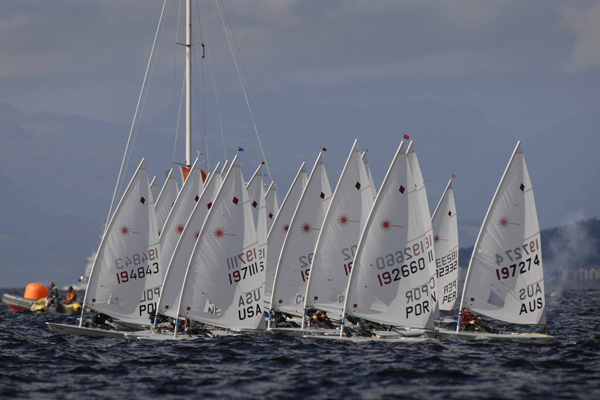
Photo: Mark Turner
Evie Van Acker (BEL) started off the pin end of the start line and was able to get into the best of the early wind pressure, leading the yellow flight race from start to finish with Multala second and Poland’s Joanna Maksymiuk taking third.
While the yellow fleet got away with perhaps the better breeze, the blue fleet suffered a big left wind shift immediately after the start and then a big shift to the right at the top end of their beat. But the most important challenge was to knit together the strands of best wind pressure.
Singapore’s Elizabeth Yin won the blue flight race ahead of Spain’s Fatima Reyes, while fifth place for Mexico’s Tania Elias Calles Wolf ensures her consistent string of scores remains intact and she now lies third.
Largs has proven a testing challenge in brisker winds, but with the breezes now expected to drop to the lower end of the scale for the second half of the regatta, perhaps it is only likely to get more difficult. In a very high standard of fleet the stakes get higher and higher.
The host country’s Skandia Team GBR sailors had a mixed day. Ali Young finished in 28th but holds 12th overall, whilst Scotland’s Charlotte Dobson’s 20th leaves her lying 23rd overall.
In the Men’s championship Poland’s Marcin Rudawski scored his fourth win from five starts to sit one point clear of his compatriot Wojciech Zemke, while Holland’s Ben Kopelaar lies third.
Laser Radial World Championships, Largs, Scotland
Women's Overall after Day 3, including one discard.
1 S Multala (FIN) 4,3,1,(49),2 = 10pts
2 M Bouwmeester (NED) 2,1,5,(7), 6 = 14pts
3 T Elias Calles Wolf (MEX) 4,(10),7,5,5 = 21pts
4 S Steyaert (FRA) (23), 4, 1, 3, 15 = 23pts
5 T Drozdovskaya (BLR) 1,5,14,3,(32) = 23pts
6 P Railey (USA) 3,1,4,16,(18) = 24pts
7 V Fenclova (CZE) 17,5,3,(22),3 = 28pts
8 S Lihan (USA) 8,3,10,10,(25) = 31pts
9 E Van Acker (BEL) 6,11,(21),14,1 = 32pts
10 T Mhelic (CRO) 15,8,3,8,(35) = 34pts
Men Overall after Day 3, including one discard.
1 M Rudawski (POL) 1,(2),1,1,1 Nett = 4pts
2 W Zemke (POL) 1,1,2,1,(7.0) = 5pts
3 B Koppelaar (NED) 9,4,1,(37),4 = 18pts
4 Y Hummel (NED) 9,1,(24),2,7 = 19pts
5 M Kiss (USA) 4,10,3,(29),2 = 19pts
Quotes:
Evie Van Acker (BEL): “I had a good start at the pin end of the line. There were not so many people there and I was able to pull out a little bit. I tacked again to get the fresher pressure and then I was leading at the first mark from Laura Baldwin and Sari Multala behind her.”
“Downwind I was really fast and on the right side with the current. When the wind dropped and dropped the current became more and more important and from there I was just defending.”
Marit Bouwmeester (NED): “It was big funny, and very difficult at times. I made a good recovery, mostly on the downwinds.”
Sari Multala (FIN): “ I was starting in the middle and had clear air and so could choose where I wanted to go. There looked to be some pressure on the right and in fact the people who were in it actually did not seem to get very far in it. So actually I got into the first pressure from the left, and there were actually a couple of boats from the far left who did better. So both the sides were OK. On the run I got from third to second where I stayed. I needed a good race and got one.”
I had hoped we could have got out a little earlier because really it was not so strong and it would have been good to get a second race.
Charlotte Dobson (GBR): “It was very patchy off the start line and I managed to miss the first puff and then struggled from there but managed to catch up from there, and had a good last beat. But really with the forecast we have I think racing pretty much starts all over again”
Racing Schedule
Laser Radial Women’s and Men’s World Championships
Qualification Series Friday 9th to Sunday 11th July
Final Series Monday 12th to Wednesday 14th July
Prize Giving Wednesday 14th July
Irish Sailors Perform at Warnemunde
Ireland's Laser Radial sailors are making impressive headway in a huge Laser Radial fleet at the Warnemunde Woche regatta in Germany.
Rory Lynch has kept his head and posted two top five results so far to sit just inside the top ten in ninth overall, in the 144-boat fleet. Lynch could soon be joined by Courtown sailor Philip Doran who has posted similar results but is currently hampered by a black flag and is hanging on in 17th. Ross Vaughan is eight places further back and makes up the top three Irish sailors at this stage.
In the 66-boat Laser 4.7 fleet, Leo Hickey is the top Irish boat in 12th with Stephen Duke following in 33rd.
Racing continues today. The event website is HERE, with results hard to find, but HERE




























